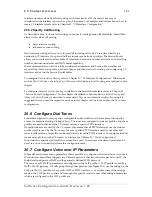
182
CS Context Overview
•
Filters
•
DTMF Relay
•
Echo Canceler
•
Silence Compression
•
Voice Volume
•
Dejitter Buffer
Parameters which can be overwriten on a CS interface are:
•
DTMF Relay
•
Echo Canceler
•
Silence Compression
•
Voice Volume
•
Dejitter Buffer
For configuring the general VoIP parameters refer to Chapter 26, “VoIP Profile Configuration”. Some
Settings can greatly affect the voice quality perceived by the user and the bandwith requirements of
VoIP connections. Therefore be sure you understand the meaning of the commands prior to
changing any settings. Most of the default values of this parameters are suitable, so that you
generally do not need to perform this configuration tasks.
20.8 Configure ISDN Ports
ISDN ports represents physical ports on the SmartNode. The configuration of the ISDN ports
depends on the port type (BRI or PRI), and on the connected voice device. To configure the ISDN
ports refer to Chapter 24, “ISDN Port Configuration”
.
20.9 Configure an ISoIP VoIP Connection
To configure an ISoIP connection you need to specify the voice codec selection and the call signaling
method.
The codec determines the voice compression technique. The codec which is used by default for a
ISoIP voice connection is specified in the ISoIP gateway. All calls through this ISoIP gateway use
these codec. If there is a specific ISoIP interface which needs to use another codec than the default
codec specified in the ISoIP gateway, it is possible to overwrite the default codec for this interface.
For information how to configure the default codec selection for an ISoIP voice connection refer to
Chapter 25, “Gateway Configuration”.
The call signaling method specifies the call setups to the destination SmartNode. In ISoIP there is one
configuration methos, 'direct call signaling'. This means that every ISoIP call needs the IP address of
the destination SmartNode. Therefore in every ISoIP interface a remote IP address is specified. For
examples and information on how to configure direct call signaling for ISoIP voice connections, refer
to Chapter 21, “CS Interface Configuration”.
20.10 Configure a H.323 VoIP Connection
To configure a H.323 connection you have to specify the voice codec selection, the call signaling
method and Q.931 tunneling.
Configuring the voice codec for an H.323 connection differs from the procedure used for ISoIP. In
Software Configuration Guide, Revision 1.03
the H.323 gateway a list of all possible codecs which we want to use we have to specified, and in the
H.323 interface one of these listed codecs we have to specified. If no codec is specified in the H.323
















































